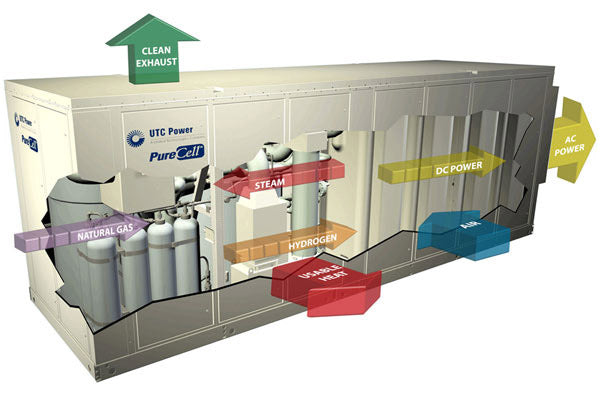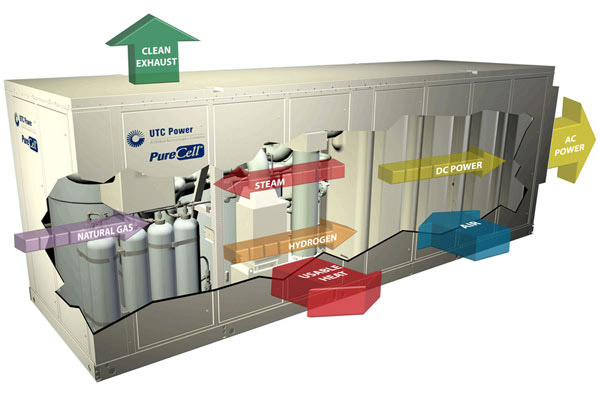News
Energy Conversion via a Biogas Fuel Cell: What are the environmental & economic costs?


A biogas fuel cell produces direct current electricity via an electrochemical process as opposed to combustion that drives a mechanical process that drives an electrical generator to produce power. This electrochemical process produces much lower criteria pollutant emissions, and even no emissions in some cases. Stationary biogas fuel cells are typically the high-temperature internal reforming fuel cells such as solid oxide fuel cells and molten carbonate fuel cells. Due to high internal temperatures within these biogas fuel cells, they are able to reform methane with steam within the fuel cell and produce hydrogen that reacts with oxygen to generate power.
In California, there are around four hundred stationary fuel cells — eleven of which are biogas fuel cells — that collectively have the capacity to generate 180 megawatts of electricity.
Biogas Fuel Cell Efficiency
According to the EPA report, Evaluating the Air Quality, Climate & Economic Impacts of Biogas Management Technologies, the efficiency of converting biogas into electricity using internal-reforming biogas fuel cells tends to range from 42-54% net [based on a higher heating value and ambient air temperature of 60 °F]. Based on an efficiency rate of 45%, input energy ranges from around 1.5 million international British thermal units per hour (MMBtu/hour) with an input flow rate of 42 standard cubic feet per minute for a 200-kilowatt biogas fuel cell to 45.5 MMBtu/hour with an input flow rate of 1260 cubic feet per minute for a 6000-kilowatt biogas fuel cell (see table 18 on page 26 of the EPA report).
Emissions Associated with a Biogas Fuel Cell
Criteria Pollutants
One of the benefits of biogas fuel cells is that they produce extremely low atmospheric emissions. Any emissions produced are a result of oxidation or combustion of anode off-gas which consists of hydrogen that has not reacted with oxygen, carbon monoxide, and volatile organic compounds. The anode gas is typically processed by surface or catalytic burners which oxidize these components while emitting very low nitrogen oxide emissions.
Green House Gas emissions
Emission factors for greenhouse gases produced by biogas fuel cells are as follows: the average greenhouse gas emission factor for methane is 0.019 lbs CH4/megawatt hour or 0.0026 lbs CH4/MMBtu, while the average GHG emission factor for carbon dioxide is 1450 lbs CO2/megawatt hour or 191.3 lbs CO2/MMBtu, and the average nitrous oxide emission factor is 0.002 lbs N20/megawatt hour or 0.00026 lbs N2O/MMBtu.
Based on the emission factors above together the global warming potential over 100 years (GWP100) of the greenhouse gas in question, the output-based greenhouse gas emissions (carbon dioxide equivalent) of methane for biogas fuel cells is estimated at 0.66 lbs CO2eq/MWh. The greenhouse gas emissions of biogenic carbon dioxide is estimated at 1450 lbs CO2eq/MWh. The greenhouse gas emissions of nitrous oxide is estimated at 0.58 lbs CO2eq/MWh. Emission factors for criteria pollutants and greenhouse gases for biogas fuel cells can be viewed in Table 19 on page 26 of the EPA report).
Costs Associated with Biogas Fuel Cells
Installation costs for biogas fuel cells are comparatively high, ranging from over $8,000/kW for a fuel cell with a 250-300 kW capacity to around $3,800/kW for a 6,140 kW fuel cell including gas cleaning equipment, engineering, permits, etc (see Table 20 on page 27 of the EPA report).
Estimated levelized cost of energy for biogas fuel cells ranges from $0.164 per kiloWatt hour for a 200 kW fuel cell to $0.079 per kiloWatt hour for a 6,000 kW fuel cell (see Table 21 & Figure 21 on page 28 of the EPA report).
WillidaUTC, CC BY-SA 3.0, via Wikimedia Commons


